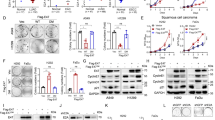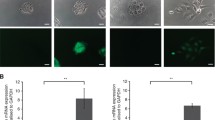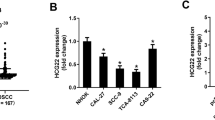Abstract
Purpose
Our previous study has revealed that EphA2 overexpression is significantly associated with aggressive behavior and poor prognosis in patients with squamous-cell carcinoma of the head and neck (SCCHN). However, the function of EphA2 in tumorigenesis and cervical lymph node metastasis of SCCHN has never been elucidated in vivo.
Methods
EphA2 was knocked down in SCCHN cell lines. CCK-8 assays, fluorescence-activated cell sorting analysis, invasion and migration assays were performed in vitro. In vivo tumorigenicity assays were performed, and the impact on cervical lymph node metastasis was evaluated.
Results
The present investigation demonstrated that suppression of EphA2 resulted in a significant inhibition of proliferation, migration, invasion of SCCHN cells in vitro and markedly diminished their tumorigenicity and lymph node metastasis in vivo.
Conclusions
These results suggest that EphA2 plays a critical role in SCCHN growth and metastasis and may be a promising therapeutic target to prevent the progression of SCCHN.





Similar content being viewed by others
References
Bogan C, Chen J, O’Sullivan MG et al (2009) Loss of EphA2 receptor tyrosine kinase reduces ApcMin/+ tumorigenesis. Int J Cancer 124:1366–1371
Brannan JM, Dong W, Prudkin L et al (2009a) Expression of the receptor tyrosine kinase EphA2 is increased in smokers and predicts poor survival in non-small cell lung cancer. Clin Cancer Res 15:4423–4430
Brannan JM, Sen B, Saigal B et al (2009b) EphA2 in the early pathogenesis and progression of non-small cell lung cancer. Cancer Prev Res (Phila) 2:1039–1049
Brantley-Sieders DM, Zhuang G, Hicks D et al (2008) The receptor tyrosine kinase EphA2 promotes mammary adenocarcinoma tumorigenesis and metastatic progression in mice by amplifying ErbB2 signaling. J Clin Invest 118:64–78
Carles-Kinch K, Kilpatrick KE, Stewart JC et al (2002) Antibody targeting of the EphA2 tyrosine kinase inhibits malignant cell behavior. Cancer Res 62:2840–2847
Duxbury MS, Ito H, Zinner MJ et al (2004) EphA2: a determinant of malignant cellular behavior and a potential therapeutic target in pancreatic adenocarcinoma. Oncogene 23:1448–1456
Han L, Dong Z, Qiao Y et al (2005) The clinical significance of EphA2 and Ephrin A-1 in epithelial ovarian carcinomas. Gynecol Oncol 99:278–286
Herath NI, Spanevello MD, Sabesan S et al (2006) Over-expression of Eph and ephrin genes in advanced ovarian cancer: ephrin gene expression correlates with shortened survival. BMC Cancer 6:144
Ireton RC, Chen J (2005) EphA2 receptor tyrosine kinase as a promising target for cancer therapeutics. Curr Cancer Drug Targets 5:149–157
Jemal A, Siegel R, Xu J et al (2010) Cancer statistics, 2010. CA Cancer J Clin 60:277–300
Kinch MS, Moore MB, Harpole DH Jr (2003) Predictive value of the EphA2 receptor tyrosine kinase in lung cancer recurrence and survival. Clin Cancer Res 9:613–618
Koolpe M, Dail M, Pasquale EB (2002) An ephrin mimetic peptide that selectively targets the EphA2 receptor. J Biol Chem 277:46974–46979
Landen CN Jr, Chavez-Reyes A, Bucana C et al (2005) Therapeutic EphA2 gene targeting in vivo using neutral liposomal small interfering RNA delivery. Cancer Res 65:6910–6918
Landen CN Jr, Lu C, Han LY et al (2006) Efficacy and antivascular effects of EphA2 reduction with an agonistic antibody in ovarian cancer. J Natl Cancer Inst 98:1558–1570
Lin YG, Han LY, Kamat AA et al (2007) EphA2 overexpression is associated with angiogenesis in ovarian cancer. Cancer 109:332–340
Liu Y, Xie C, Zhang X et al (2010) Elevated expression of HMGB1 in squamous-cell carcinoma of the head and neck and its clinical significance. Eur J Cancer 46:3007–3015
Liu Y, Zhang X, Qiu Y et al (2011) Clinical significance of EphA2 expression in squamous-cell carcinoma of the head and neck. J Cancer Res Clin Oncol 137:761–769
Lu C, Shahzad MM, Wang H et al (2008) EphA2 overexpression promotes ovarian cancer growth. Cancer Biol Ther 7:1098–1103
Mamelle G (2000) Selective neck dissection and sentinel node biopsy in head and neck squamous cell carcinomas. Recent Results Cancer Res 157:193–200
Mamelle G, Pampurik J, Luboinski B et al (1994) Lymph node prognostic factors in head and neck squamous cell carcinomas. Am J Surg 168:494–498
Margaryan NV, Strizzi L, Abbott DE et al (2009) EphA2 as a promoter of melanoma tumorigenicity. Cancer Biol Ther 8:279–288
Meade-Tollin L, Martinez JD (2007) Loss of p53 and overexpression of EphA2 predict poor prognosis for ovarian cancer patients. Cancer Biol Ther 6:288–289
Pasquale EB (1997) The Eph family of receptors. Curr Opin Cell Biol 9:608–615
Pasquale EB (2005) Eph receptor signalling casts a wide net on cell behaviour. Nat Rev Mol Cell Biol 6:462–475
Pasquale EB (2008) Eph-ephrin bidirectional signaling in physiology and disease. Cell 133:38–52
Rivera RS, Gunduz M, Nagatsuka H et al (2008) Involvement of EphA2 in head and neck squamous cell carcinoma: mRNA expression, loss of heterozygosity and immunohistochemical studies. Oncol Rep 19:1079–1084
Shao Z, Zhang WF, Chen XM et al (2008) Expression of EphA2 and VEGF in squamous cell carcinoma of the tongue: correlation with the angiogenesis and clinical outcome. Oral Oncol 44:1110–1117
Sulman EP, Tang XX, Allen C et al (1997) ECK, a human EPH-related gene, maps to 1p36.1, a common region of alteration in human cancers. Genomics 40:371–374
Thaker PH, Deavers M, Celestino J et al (2004) EphA2 expression is associated with aggressive features in ovarian carcinoma. Clin Cancer Res 10:5145–5150
Walker-Daniels J, Coffman K, Azimi M et al (1999) Overexpression of the EphA2 tyrosine kinase in prostate cancer. Prostate 41:275–280
Wu Z, Doondeea JB, Moghaddas Gholami A et al. (2011) Quantitative chemical proteomics reveals new potential drug targets in head and neck cancer. Mol Cell Proteomics [Epub ahead of print]
Wykosky J, Gibo DM, Stanton C et al (2005) EphA2 as a novel molecular marker and target in glioblastoma multiforme. Mol Cancer Res 3:541–551
Zantek ND, Azimi M, Fedor-Chaiken M et al (1999) E-cadherin regulates the function of the EphA2 receptor tyrosine kinase. Cell Growth Differ 10:629–638
Zelinski DP, Zantek ND, Stewart JC et al (2001) EphA2 overexpression causes tumorigenesis of mammary epithelial cells. Cancer Res 61:2301–2306
Zhang X, Liu Y, Gilcrease MZ et al (2002) A lymph node metastatic mouse model reveals alterations of metastasis-related gene expression in metastatic human oral carcinoma sublines selected from a poorly metastatic parental cell line. Cancer 95:1663–1672
Zhang X, Su L, Pirani AA et al (2006) Understanding metastatic SCCHN cells from unique genotypes to phenotypes with the aid of an animal model and DNA microarray analysis. Clin Exp Metastasis 23:209–222
Zhou Z, Yuan X, Li Z et al (2008) RNA interference targeting EphA2 inhibits proliferation, induces apoptosis, and cooperates with cytotoxic drugs in human glioma cells. Surg Neurol 70:562–568 (discussion 568–569)
Acknowledgments
This work was supported by grants from the National Natural Science Foundation of China (No:81172558, 81071757, 30872852, 30901664), the Key Program of Natural Science Foundation of Hunan Province (2010TP4012-1), the Research Fund for the Doctoral Program of Higher Education of China (20100162110036, 20090162110065) and the Fundamental Research Funds for the Central Universities.
Conflict of interest
We declare that we have no conflict of interest.
Author information
Authors and Affiliations
Corresponding authors
Rights and permissions
About this article
Cite this article
Liu, Y., Yu, C., Qiu, Y. et al. Downregulation of EphA2 expression suppresses the growth and metastasis in squamous-cell carcinoma of the head and neck in vitro and in vivo. J Cancer Res Clin Oncol 138, 195–202 (2012). https://doi.org/10.1007/s00432-011-1087-9
Received:
Accepted:
Published:
Issue Date:
DOI: https://doi.org/10.1007/s00432-011-1087-9




